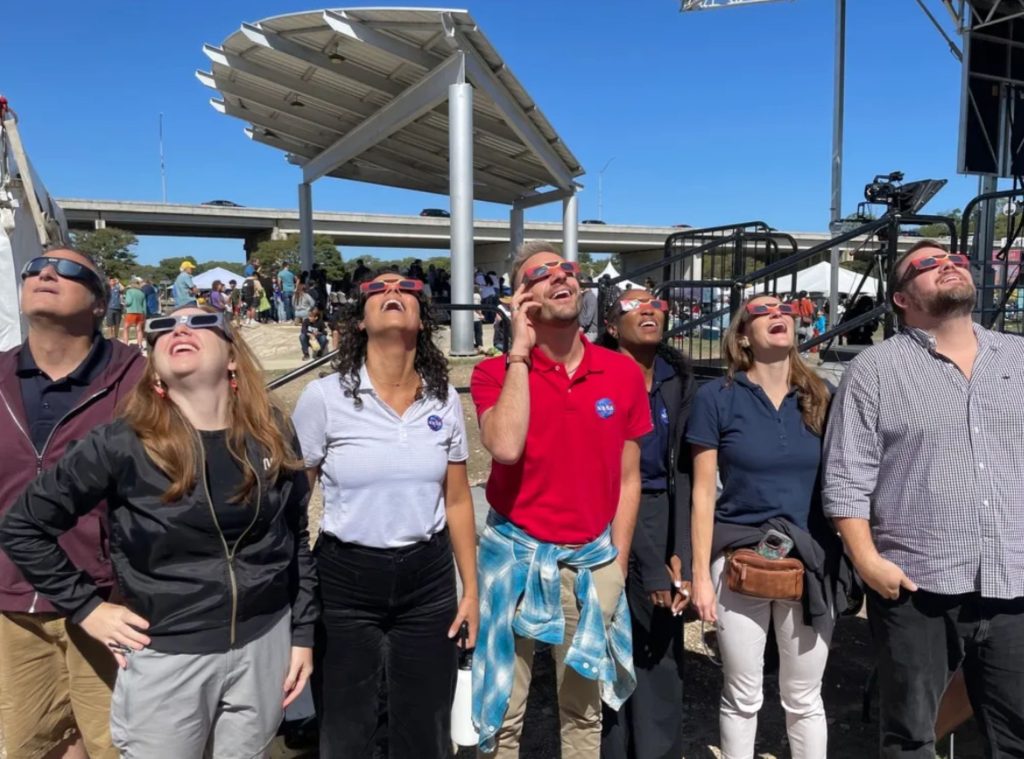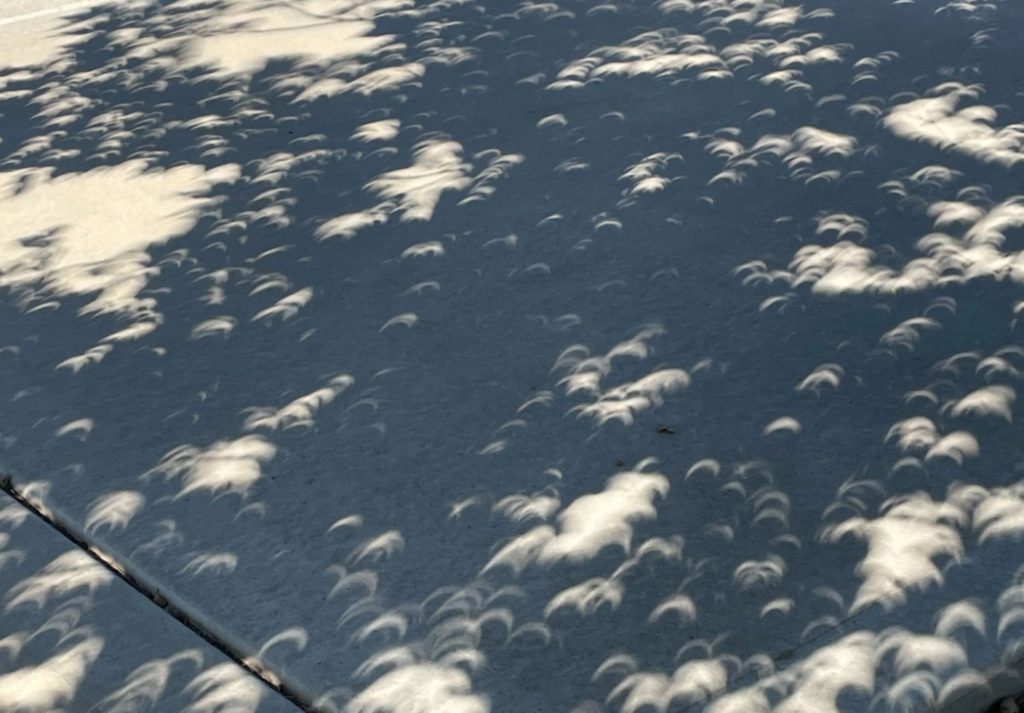Special solar spectacle rises with the sun Wednesday in Hawai‘i
A solar spectacle is on the horizon — literally — as Hawai‘i greets the dawn Wednesday.

The islands are the only place in the United States where you can get at least a partial view of the final eclipse of 2024, and this time it’s an annular solar eclipse that will sweep a third of the way around the globe from the North Pacific to the South Atlantic.
It will be the second partial solar eclipse to be visible in Hawai‘i this year.
The solar event begins at 5:44 a.m., so it will be underway as the sun rises. It ends about 2 hours later.
Make sure you have a free line of sight and look east, toward the horizon, to watch.
Here’s a look at when you can expect to see the partial solar eclipse in some specific spots on Kaua‘i and the Big Island.
Kauaʻi
- Līhuʻe
Begins: 6:29 a.m.
Maximum coverage: 6:45 a.m.
Ends: 7:51 a.m. - Hanalei
Begins: 6:29 a.m.
Maximum coverage: 6:45 a.m.
Ends: 7:50 a.m. - Waimea Canyon State Park
Begins: 6:30 a.m.
Maximum coverage: 6:45 a.m.
Ends: 7:51 a.m. - Kapaʻa
Begins: 6:29 a.m.
Maximum coverage: 6:45 a.m.
Ends: 7:51 a.m.
Big Island
- Hilo
Begins: 6:11 a.m.
Maximum coverage: 6:46 a.m.
Ends: 7:56 a.m. - Kailua-Kona
Begins: 6:15 a.m.
Maximum coverage: 6:46 a.m.
Ends: 7:56 a.m. - Waimea
Begins: 6:14 a.m.
Maximum coverage: 6:46 a.m.
Ends: 7:55 a.m. - Nāʻālehu
Begins: 6:13 a.m.
Maximum coverage: 6:46 a.m.
Ends: 7:57 a.m. - Halepōhaku area atop Mauna Kea
Begins: 6:13 a.m.
Maximum coverage: 6:46 a.m.
Ends: 7:56 a.m.
The first partial solar eclipse visible in Hawai‘i this year was April 8 when the moon completely blacked out the sun as it moved from south to north over the mainland during the Great North American Eclipse.
Unlike a total solar eclipse when the moon passes between the sun and Earth and completely covers the sun, during an annular eclipse the moon is farther away from its constant cosmic companion than usual and appears smaller, so it does not block out the sun 100%.
That creates a brightly burning “ring of fire” in the sky.
October’s annular solar eclipse coincides with a micro new moon — think of it as the opposite of a supermoon — that will only cover 87% of the sun’s disk.
Only those in a narrow path called the path of annularity, which is just 190 miles wide, will be able to see the ring when the eclipse is in totality.
That eclipse’s main path Wednesday is mostly over water save for going over Rapa Nui, also known as Easter Island; the Aysén Region, a remote and sparsley populated part of southern Chile; and Argentina’s Santa Cruz Province.
There are only about 175,000 people living in the “ring of fire” path.
A large portion of the Pacific, southern half of South America and a part of the South Atlantic, however, like Hawai‘i, including places such as American Samoa, Brazil, Fiji, Mexico, New Zealand, Paraguay, Tonga and others, will get to see a partial eclipse.

Instead of a “ring of fire,” the sun will look crescent-shaped or like a piece was removed from it.
The moon blocked only about 32% of the sun during the April partial eclipse, depending where in Hawai‘i you watched.
Despite the moon being a bit farther away than normal, Wednesday’s solar show will be even better, with Earth’s lunar partner covering more than 50% of the sun during the partial eclipse if you’re watching from the Big Island.
The moon will still cover about 45% of our solar system’s star if you’re viewing the eclipse from locations on Kaua’i.
The moon illusion is at play here this time, too, since the eclipse is happening close to the horizon.
It’s a phenomenon where supermoons and micromoons don’t look different to the naked eye, but do appear to be different in size when seen near the horizon instead of high in the sky.
The phenomenon might not be a huge deal during normal super and micromoons, “but it makes all the difference when there is a solar eclipse,” said Renate Mauland-Hus, a member of Time and Date’s astronomy team and doctorate research fellow in cosmology at the University of Oslo before joining the world’s top site for time, time zones and astronomy.
No matter what, because the sun is not completely covered, it’s not safe to look directly at the partial eclipse without proper eye protection.
Looking directly at the sun can cause serious eye injury.
Here are some tips from NASA:
- Eclipse glasses or a safe handheld solar viewer are necessary. Regular sunglasses, no matter how dark, are not safe for viewing the sun.
- Do not look at the sun through a camera lens, telescope, binoculars or any other optical device while wearing eclipse glasses or using a handheld solar viewer. Concentrated solar rays will burn through the filter.
- If you do not have eclipse glasses or a handheld solar viewer, you can view the partial eclipse indirectly. Use a pinhole projector, which has a small opening such as a hole punched in an index card, that projects an image of the sun onto a surface nearby and view the image with the sun at your back. Do not look at the sun through the pinhole. Leaves on trees also can act as natural pinholes, projecting the shape of the eclipse on the surface underneath them.
For additional safety information, click here.

This won’t be the last time to catch a partial eclipse of the solar or lunar kind in the near future. Several will be visible from Hawai‘i during the next 12 years, including total lunar eclipses in March and September 2025 and March 2026.
Another total lunar eclipse will be visible from the islands to close out 2028 on Dec. 31.
The next solar eclipse of any kind that Hawai’i will experience won’t be until Nov. 14, 2031, when the islands will get to see another partial solar eclipse.
And if you’re holding out to see the next time the sun is almost or fully covered by the moon over Hawai‘i, it’s going to be a hot minute for either kind of solar eclipse.
It won’t be until early February 2046, a little more than 21 years from now, when we’ll be in the main path of a “ring of fire” eclipse, and the next total solar eclipse, when the skies over the islands go dark as the moon blots out the sun, will be nearly 82 years from now in early May 2106.
So if you can, be sure to get up and get out to catch Wednesday’s solar show.
Even the weather looks like it will cooperate.
The National Weather Service forecast for windward Kaua‘i shows mostly sunny conditions with some scattered showers and only isolated showers for leeward areas.
Windward areas of the Big Island are expected to be partly sunny and leeward spots sunny in the morning.
By some chance if you can’t get out of the house or away from work to catch at least a glimpse of the partial eclipse, check out the Time and Date livestream on YouTube.









